Abstract
We have applied a specific and accurate high pressure liquid chromatographic technique to determine fasting serum glycine and taurine conjugates of individual bile acids in patients with primary biliary cirrhosis before and during ursodeoxycholic acid therapy. The study was carried out in nine patients in whom the diagnosis of primary biliary cirrhosis was established according to accepted criteria. After one year of UDCA therapy liver function tests significantly improved. Total serum bile acid concentration did not change significantly (29.2 (31.5) v 28.3 (26.4) microM). Total UDCA (1.7 (2.2) v 13.3 (14.5) microM) and glyco UDCA (0.8 (1.6) v 10.9 (11.4 microM) but not tauro UDCA levels increased significantly (p less than 0.01); UDCA (7.7 (12.6) v 40.2 (12.7)%) became the major species of the circulating bile acids. Primary bile acids (23 (28.3) v 11.2 (10.5) and their glycoconjugates fell significantly (p less than 0.01). There were no significant changes in the concentrations of conjugates of the secondary bile acids (4.5 (3.8) v 3.9 (3.0]. Our study shows that oral administration of UDCA to patients with primary biliary cirrhosis induced marked changes in the circulating pool of endogenous bile acids together with improvement in liver function test values. The data also suggest that the beneficial effect of longterm administration of UDCA in these patients might be mediated through changes in the circulating primary bile acids and UDCA rather than through changes in the circulating secondary bile acids, deoxycholate and lithocholate.
Full text
PDF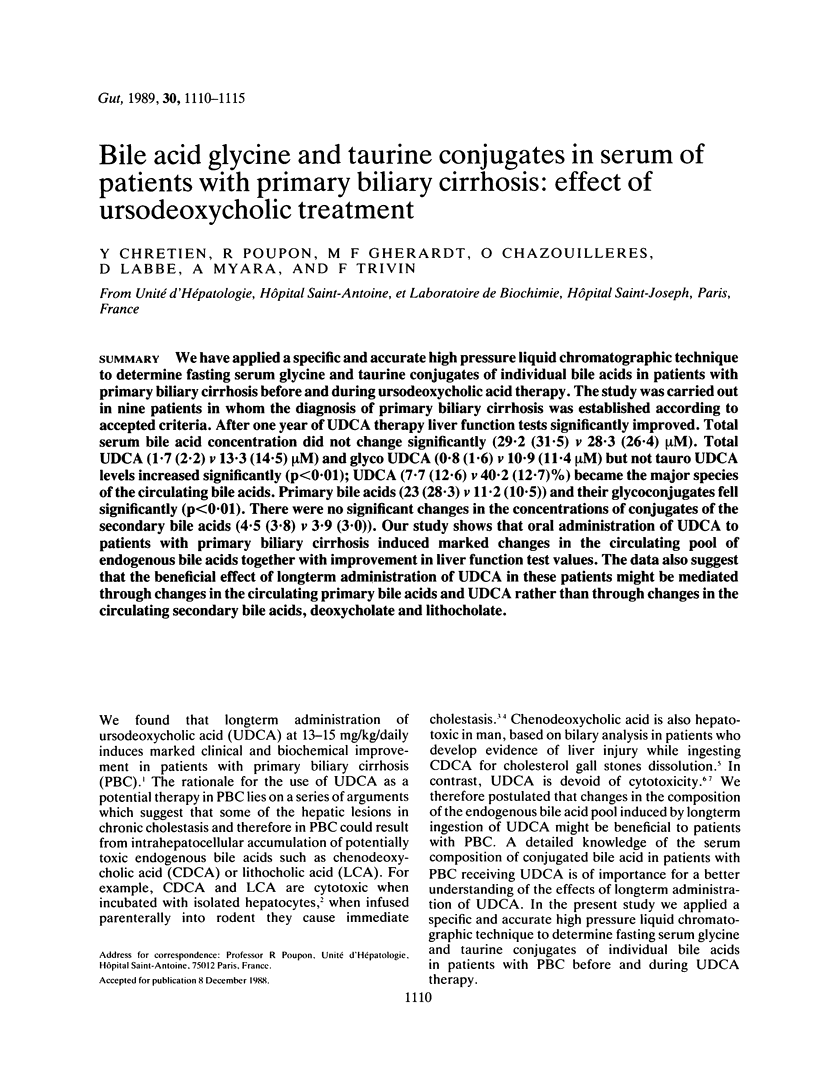
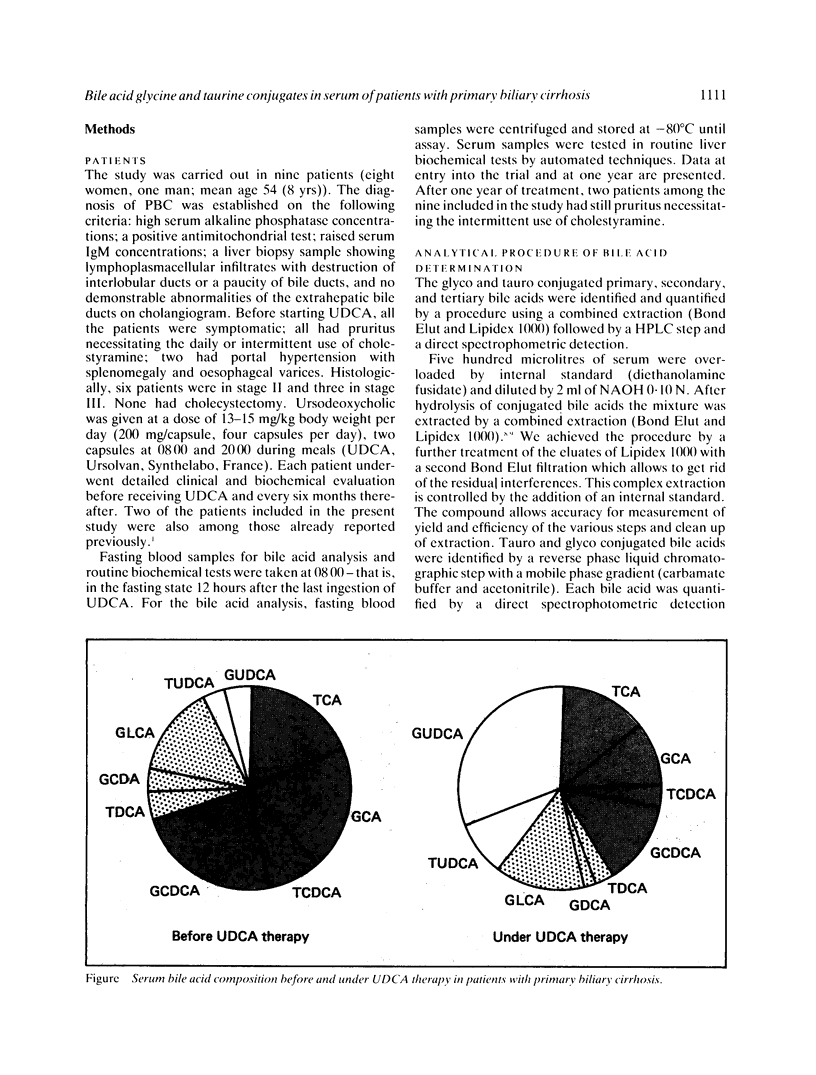
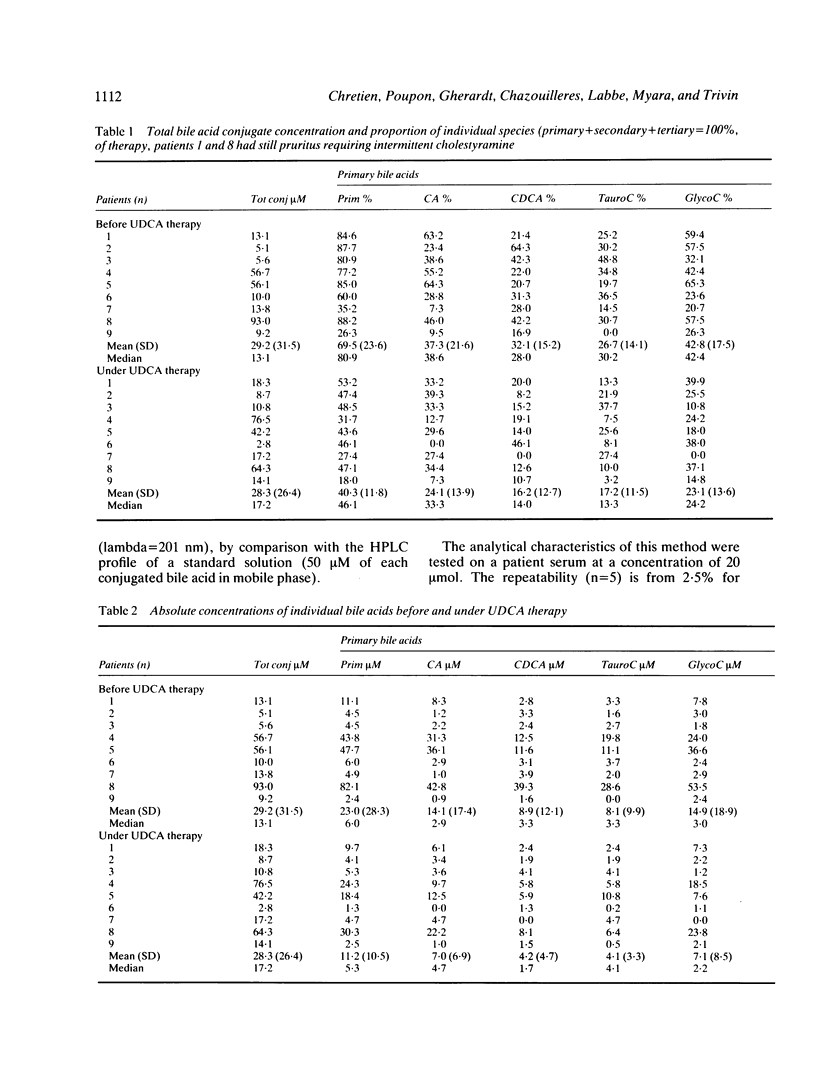
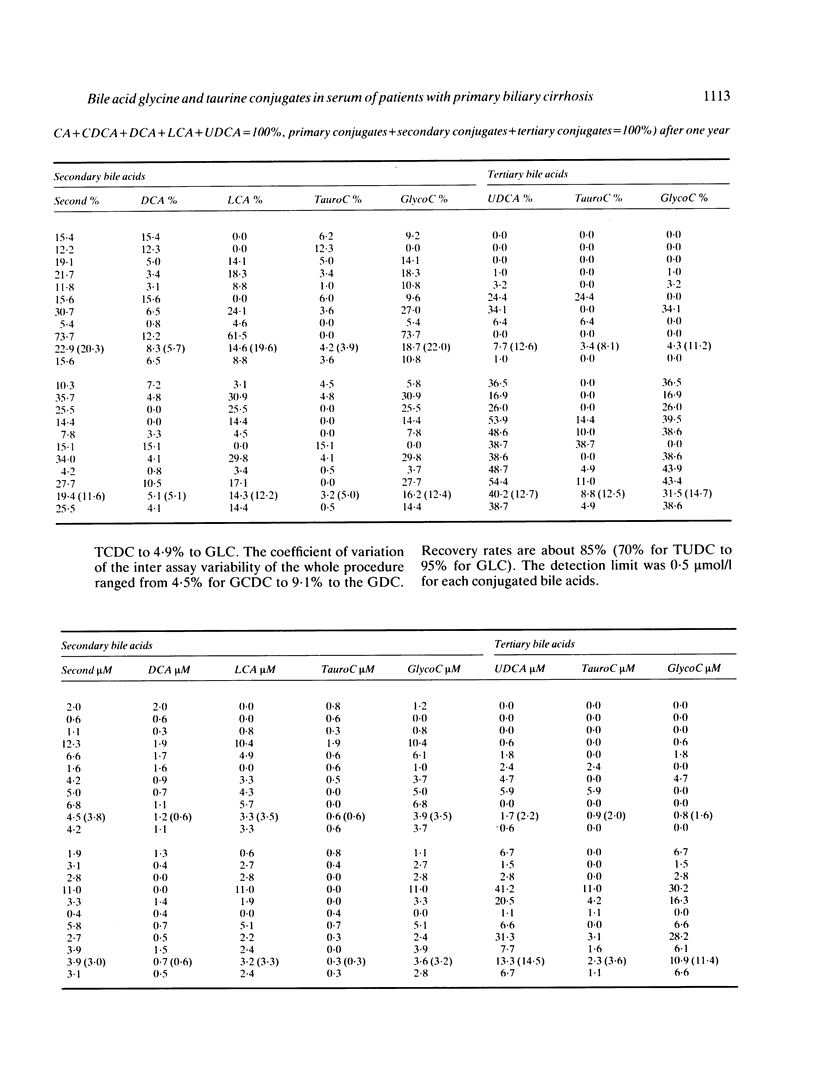
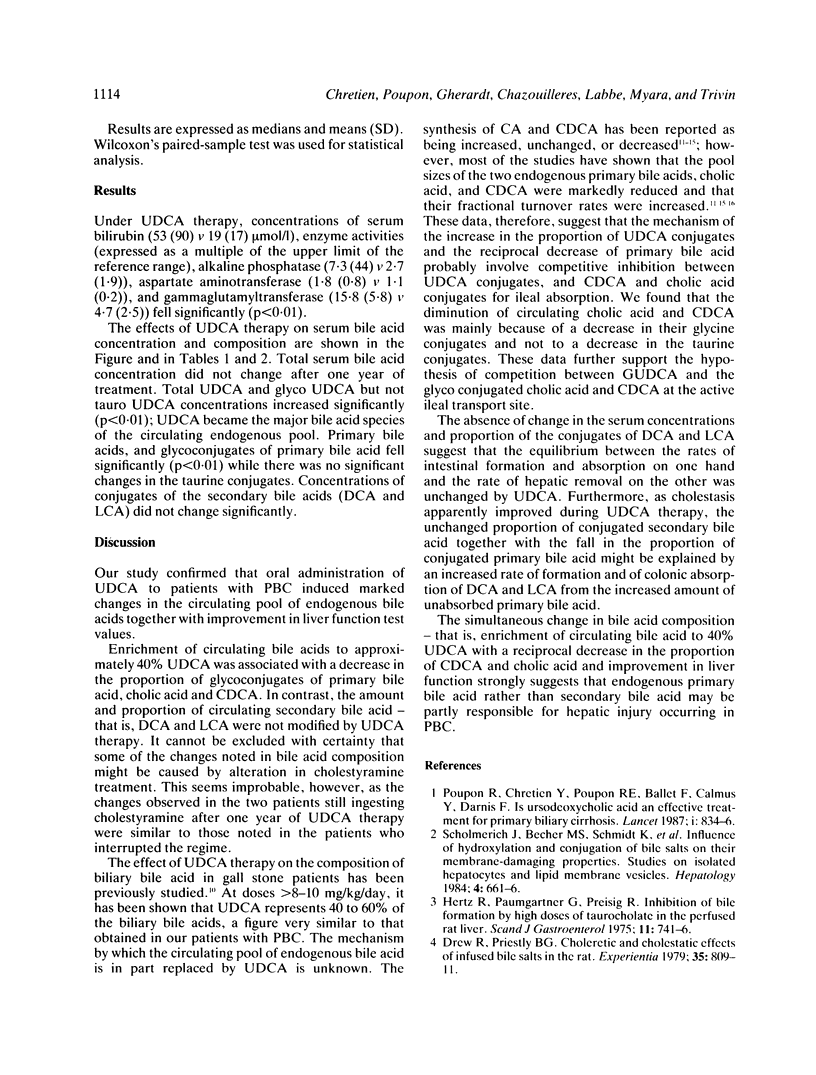
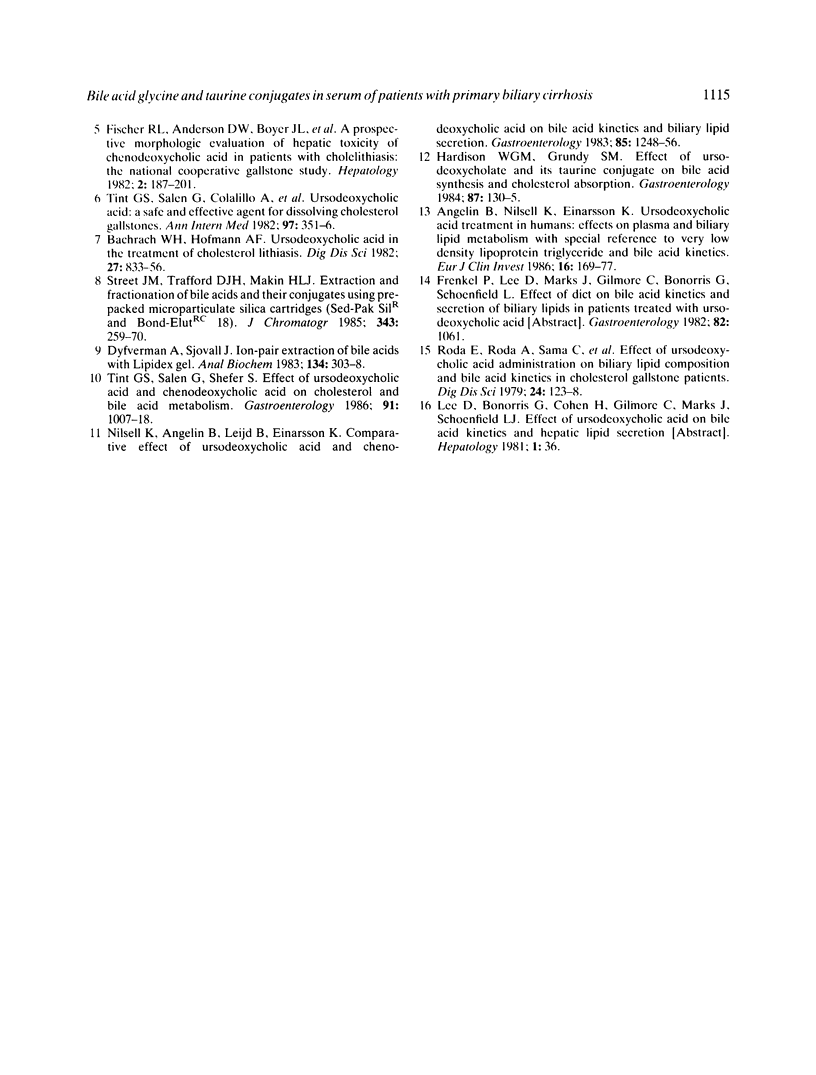
Selected References
These references are in PubMed. This may not be the complete list of references from this article.
- Angelin B., Nilsell K., Einarsson K. Ursodeoxycholic acid treatment in humans: effects on plasma and biliary lipid metabolism with special reference to very low density lipoprotein triglyceride and bile acid kinetics. Eur J Clin Invest. 1986 Apr;16(2):169–177. doi: 10.1111/j.1365-2362.1986.tb01325.x. [DOI] [PubMed] [Google Scholar]
- Bachrach W. H., Hofmann A. F. Ursodeoxycholic acid in the treatment of cholesterol cholelithiasis. Part II. Dig Dis Sci. 1982 Sep;27(9):833–856. doi: 10.1007/BF01391378. [DOI] [PubMed] [Google Scholar]
- Blacklock H. A., Gilmore M. J., Prentice H. G., Hazlehurst G. R., Evans J. P., Ma D. D., Knight C. B., Hoffbrand A. V. ABO-incompatible bone-marrow transplantation: removal of red blood cells from donor marrow avoiding recipient antibody depletion. Lancet. 1982 Nov 13;2(8307):1061–1064. doi: 10.1016/s0140-6736(82)90003-4. [DOI] [PubMed] [Google Scholar]
- Drew R., Priestly B. G. Choleretic and cholestatic effects of infused bile salts in the rat. Experientia. 1979 Jun 15;35(6):809–811. doi: 10.1007/BF01968265. [DOI] [PubMed] [Google Scholar]
- Dyfverman A., Sjövall J. Ion-pair extraction of bile acids with Lipidex gel. Anal Biochem. 1983 Oct 15;134(2):303–308. doi: 10.1016/0003-2697(83)90301-9. [DOI] [PubMed] [Google Scholar]
- Fisher R. L., Anderson D. W., Boyer J. L., Ishak K., Klatskin G., Lachin J. M., Phillips M. J. A prospective morphologic evaluation of hepatic toxicity of chenodeoxycholic acid in patients with cholelithiasis: the National Cooperative Gallstone Study. Hepatology. 1982 Mar-Apr;2(2):187–201. doi: 10.1002/hep.1840020202. [DOI] [PubMed] [Google Scholar]
- Hardison W. G., Grundy S. M. Effect of ursodeoxycholate and its taurine conjugate on bile acid synthesis and cholesterol absorption. Gastroenterology. 1984 Jul;87(1):130–135. [PubMed] [Google Scholar]
- Herz R., Paumgartner G., Preisig R. Inhibition of bile formation by high doses of taurocholate in the perfused rat liver. Scand J Gastroenterol. 1976;11(7):741–746. [PubMed] [Google Scholar]
- Nilsell K., Angelin B., Leijd B., Einarsson K. Comparative effects of ursodeoxycholic acid and chenodeoxycholic acid on bile acid kinetics and biliary lipid secretion in humans. Evidence for different modes of action on bile acid synthesis. Gastroenterology. 1983 Dec;85(6):1248–1256. [PubMed] [Google Scholar]
- Poupon R., Chrétien Y., Poupon R. E., Ballet F., Calmus Y., Darnis F. Is ursodeoxycholic acid an effective treatment for primary biliary cirrhosis? Lancet. 1987 Apr 11;1(8537):834–836. doi: 10.1016/s0140-6736(87)91610-2. [DOI] [PubMed] [Google Scholar]
- Roda E., Roda A., Sama C., Festi D., Mazzella G., Aldini R., Barbara L. Effect of ursodeoxycholic acid administration on biliary lipid composition and bile acid kinetics in cholesterol gallstone patients. Dig Dis Sci. 1979 Feb;24(2):123–128. doi: 10.1007/BF01324739. [DOI] [PubMed] [Google Scholar]
- Schölmerich J., Becher M. S., Schmidt K., Schubert R., Kremer B., Feldhaus S., Gerok W. Influence of hydroxylation and conjugation of bile salts on their membrane-damaging properties--studies on isolated hepatocytes and lipid membrane vesicles. Hepatology. 1984 Jul-Aug;4(4):661–666. doi: 10.1002/hep.1840040416. [DOI] [PubMed] [Google Scholar]
- Street J. M., Trafford D. J., Makin H. L. Extraction and fractionation of bile acids and their conjugates using pre-packed microparticulate silica cartridges (Sep-Pak Sil and Bond-Elut C18). J Chromatogr. 1985 Oct 11;343(2):259–270. doi: 10.1016/s0378-4347(00)84596-x. [DOI] [PubMed] [Google Scholar]
- Tint G. S., Salen G., Colalillo A., Graber D., Verga D., Speck J., Shefer S. Ursodeoxycholic acid: a safe and effective agent for dissolving cholesterol gallstones. Ann Intern Med. 1982 Sep;97(3):351–356. doi: 10.7326/0003-4819-97-3-351. [DOI] [PubMed] [Google Scholar]
- Tint G. S., Salen G., Shefer S. Effect of ursodeoxycholic acid and chenodeoxycholic acid on cholesterol and bile acid metabolism. Gastroenterology. 1986 Oct;91(4):1007–1018. doi: 10.1016/0016-5085(86)90708-0. [DOI] [PubMed] [Google Scholar]


